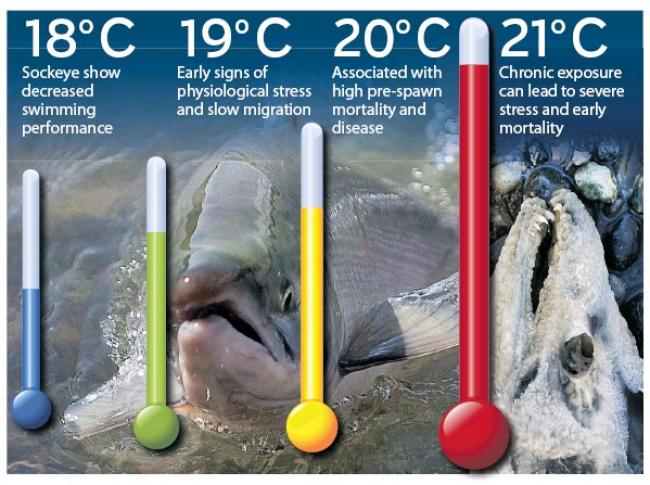Articles Menu

Record low river levels and warm water temperatures could have a devastating effect on millions of sockeye salmon headed for the Fraser River to spawn, according to a UBC biologist.
If this summer’s unusual weather conditions continue, few salmon will brave the stifling temperatures of the river, and many of those that do will die trying, Tony
Farrell said. The temperature in the Fraser River at Hope is currently edging close to 20 C and recently hit 20.5 C, a record high for this time of year and about four degrees warmer than an average year. Meanwhile, the river level was at a 25-year low by July.
“I think what most people don’t realize is that Pacific salmon have one chance to spawn and they have to go through this gauntlet of the Fraser River to make it there,” Farrell said, adding the journey can be as long as 1,000 kilometres upstream. “Fish will tend not (to) come into the Fraser River or into watersheds if it’s too hot.”
At 18 C, sockeye show decreased swimming performance, according to Fisheries and Oceans Canada.
By 20 C, they start developing diseases and dying at high rates.
At chronic exposure to water above 21 C, fish suffer from severe stress and early death. “The temperature margin for the successful migration and a failed migration is very small, just like the difference between a healthy human at 37 degrees and going to the hospital at 42,” Farrell said.
“It’s just a matter of two, three degrees and you go from fish making it to the spawning grounds to fish not making it.”
The last really warm year for Fraser River sockeye was 2004, when temperatures peaked at 21.5 C. About 70 per cent of the spawning population were not able to spawn.
“I think if the temperatures continue at these temperatures, I’d be very surprised if we don’t get quite a lot of mortality of fish making a last-ditch effort to go up,” Farrell said.
The Fraser River sockeye run is expected to begin this month. Last year’s commercial opening was Aug. 11.
The success of this year’s spawning season will depend on whether rain and cooler weather manage to lower temperatures, and if the sockeye have stored enough energy before they stop feeding ahead of the migration.
Younger salmon also face big obstacles when they make their way into the Pacific Ocean. Warmer marine temperatures mean that predator fish such as tuna and mackerel are able to move farther north, allowing them to sit in wait for the salmon smolts swimming out from the mouth of the Fraser.
“They’re probably having a good chowdown on the salmon smolts going out,” Farrell said. Taken together, warm temperatures in both the ocean and the Fraser River mean “we’re pushing the limits of our sockeye salmon,” he added.
Although it’s too early in the season to accurately predict this year’s salmon returns, federal scientists are tentatively forecasting a sockeye return of 6.8 million. Whether any sockeye fisheries will open this year depends in part on water temperatures, which will allow scientists to predict how many fish will make it back to the spawning grounds.
The first fish to return are part of the socalled early Stuart run headed to Stuart Lake, north of Prince George, and DFO numbers suggest their numbers will be very low — and therefore no commercial fisheries are planned for this group.
Low streamflow levels and warm water temperatures have already prompted the B.C. government to ban sport fishing in streams through most of the south coast, Vancouver Island and the south Okanagan. About 50 major river systems are closed and 40 are being monitored, according to provincial fisheries manager Mike Ramsay.
“This is kind of unprecedented. This level has not happened before in British Columbia, but it’s turned our thinking to developing some planning around this for future years,” he said.
Cooler temperatures at night should help some streams in the Interior stabilize by mid-August, he added, but Level 4 drought conditions in the Lower Mainland and Vancouver Island mean the situation isn’t likely to improve without substantial rain.
Ramsay pointed to the Columbia River in Oregon as a cautionary example.
“They’ve had mass die-offs of fish because of these temperature problems,” he said. “We’re not there yet, but we’re taking a precautionary approach, not having people angle these fish and trying to leave them alone as much as possible until the conditions are OK to go fishing.”
Meanwhile, the Okanagan Nation Alliance last week cut off the commercial and recreational fisheries on Osoyoos Lake because high temperatures were leading to disease and death. Fishing on nearby Kettle River was banned earlier this year.
A poor salmon return this year could mean premium prices for sockeye in stores.
UBC researchers have already forecast a possible 70 per cent increase in sockeye prices by 2050 as stocks decline.
The Daily Catch, which has four locations in Vancouver, was selling sashimigrade sockeye filets for $4.41 per 100 grams on Tuesday, or $11.99 per pound of whole fish.
But deals are still available for consumers who are prepared to shop around. At Thrifty Foods in South Surrey, sockeye filets were selling for $2.69 per 100 grams on Tuesday. The store is offering a buy-one-get-one-free sale on Wednesday, with the price of a filet set at $3.99 per 100 grams.
Julianna Fall, who works in the store’s seafood department, said sockeye filets have been as cheap as $1.88 per 100 grams this summer. During a one-day salmon festival on July 19, whole fish sold for 98 cents per 100 grams.
The prices for the rest of the summer will depend on the salmon returns, she added.
“If it’s a really good run,” Fall said, “then at the end of August you’ll see really good sales. If it’s not so much, you’ll see them earlier.”
[End of article]